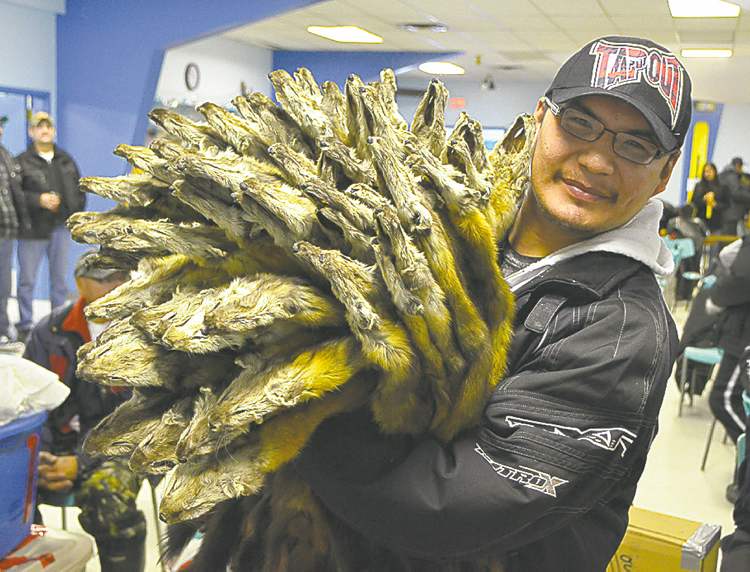Trappers are happy — very happy
Fashion driving fur prices to record heights
Advertisement
Read this article for free:
or
Already have an account? Log in here »
To continue reading, please subscribe:
Monthly Digital Subscription
$0 for the first 4 weeks*
- Enjoy unlimited reading on winnipegfreepress.com
- Read the E-Edition, our digital replica newspaper
- Access News Break, our award-winning app
- Play interactive puzzles
*No charge for 4 weeks then price increases to the regular rate of $19.00 plus GST every four weeks. Offer available to new and qualified returning subscribers only. Cancel any time.
Monthly Digital Subscription
$4.75/week*
- Enjoy unlimited reading on winnipegfreepress.com
- Read the E-Edition, our digital replica newspaper
- Access News Break, our award-winning app
- Play interactive puzzles
*Billed as $19 plus GST every four weeks. Cancel any time.
To continue reading, please subscribe:
Add Free Press access to your Brandon Sun subscription for only an additional
$1 for the first 4 weeks*
*Your next subscription payment will increase by $1.00 and you will be charged $16.99 plus GST for four weeks. After four weeks, your payment will increase to $23.99 plus GST every four weeks.
Read unlimited articles for free today:
or
Already have an account? Log in here »
Hey there, time traveller!
This article was published 09/03/2013 (4627 days ago), so information in it may no longer be current.
Since the fur industry was born in Canada more than 350 years ago, fashion and demand have always been the driving factors when it comes to how much trappers receive for their pelts. This season, trappers are smiling.
Canadian furs — both wild and farmed — are primarily sold to an international market for garments and trim. North America Fur Auction (NAFA), the largest fur auction house in North America, holds several auctions a year in Toronto. Buyers from China, Russia, Greece, Turkey, Korea, North America and Eastern European countries pack the house and bid on lots of furs.
In Manitoba, trappers get their furs to market in a variety of ways. Sometimes they sell directly to NAFA or other fur auctions. For trappers in the north, the Thompson Fur Table, held every December, provides an opportunity for trappers to get some revenue for early-season furs.

December’s event in Thompson was an early indication that prices for wild furs were definitely heading for the record books. The 207 trappers at the event took home a combined $683,559, the highest amount paid out in the past 30 year of this event. To put that in perspective, in 2004, there were over 230 trappers at that fur table. A total of $497,408 changed hands.
NAFA’s February sale in Toronto broke all kinds of records. Dave Bewick, general manager of fur operations for NAFA, said a number of factors came together to create a “perfect storm” that resulted in the most successful sale they’ve seen since the market took a nose dive in the late ’80s.
There were more than 700 buyers at the sale — 470 of them from China. Another 100 buyers came from Russia and Greece while Korea was represented with an additional 50 buyers. Thanks to strong marketing efforts, fur is in fashion in China. That, combined with the coldest winter there in 28 years, resulted in excellent prices for furs.
Fur prices have been on the upswing for several years. A parka company called Canada Goose has become wildly popular recently. Most of these parkas are outfitted with a generous coyote trim and that means prices are on the rise. Fashion, once again, dictates price.
Furs are sold in lots. Top lot is a unique designation that identifies a group of pelts of premium quality. The number of pelts in each top lot depends on the species. A top lot of coyote might include 12 pelts while a top lot of muskrat would have more than 100 pelts. Top lots sell for big money. Trappers who are lucky enough to have one of their pelts in a top lot can expect a cheque for three, four, five or even 10 times more than the price of an average pelt in the same species.
Here are some of the highlights from the NAFA auction in Toronto in February.
Fisher
Average: $157.67
Top Lot: $350.00
Increase over 2012: 50 to 70 per cent
Pelts Sold: 12,036
Marten
Average: $144.29
Top Lot: $650.00
Increase over 2012: 55 to 60 per cent
Pets Sold: 92,336
Beaver
Average: $31.03
Top Lot: $400.00
Pelts Sold: 160,250
Lynx
Average: $194.44
Top Lot: $525.00
Increase over 2012: 40 per cent
Pelts Sold: 5,223
Coyote
Average: $93.98
Top Lot: $1,400.00
Pelts Sold: 62,649
Red Fox
Average: $65.78
Top Lot: $340.00
Pelts Sold: 35,414
Shel Zolkewich writes about the outdoors, travel and food when she’s not playing outside, traveling or eating. You can reach her with your comments at shel@shelzolkewich.com


